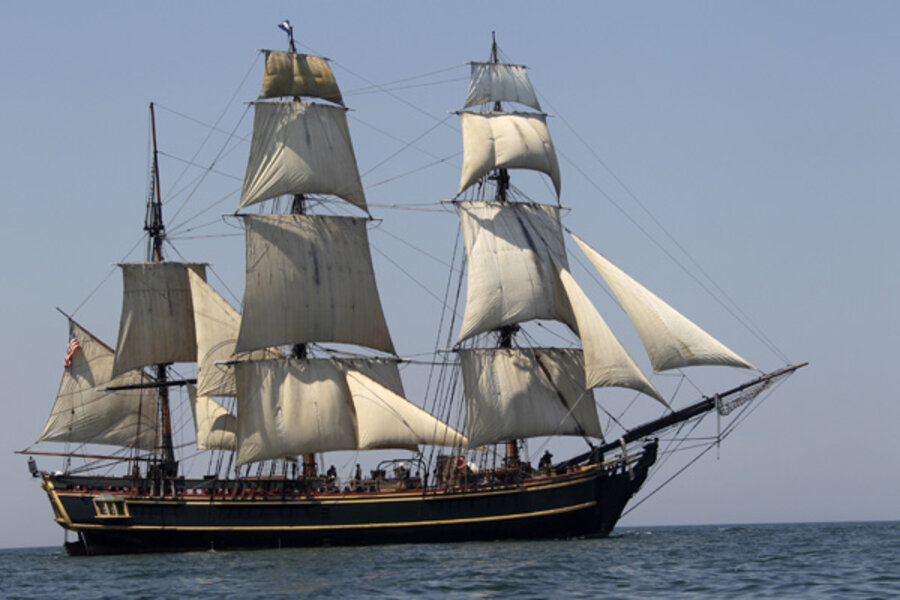HMS Bounty casualty claimed tie to mutinous Fletcher Christian
Loading...
When Claudene Christian applied earlier this year for a spot as a mate on the famous tall ship replica of the HMS Bounty, she probably had a little edge: Her family claimed a historical connection to the original ship via Fletcher Christian, who had instigated the 1789 mutiny that propelled the Bounty and its crew into maritime history and Hollywood fantasy.
In an almost inexplicable twist on that family legacy, Ms. Christian is so far the only confirmed casualty from the loss of the 1962 replica, which sank Monday off Cape Hatteras, N.C., in the high seas wrought by hurricane Sandy. The captain of the HMS Bounty, Robin Walbridge, remains missing, though the US Coast Guard has not given up the search.
Maritime historians say the Bounty story as told by Hollywood – the heroic Christian versus the evil Captain Bligh – created a false reality, as actors such as Errol Flynn, Clark Gable, Marlon Brando, and Mel Gibson all portrayed Christian. To some, Ms. Christian's death at sea seems almost as surreal, a bizarre series of events that reads like a Hollywood script.
“If there had been no movies, there would have been no replica [of the Bounty], and if there had been no replica there would have been no [Claudene] Christian aboard, so there’s this confluence of pop culture, history, and tragedy” overshadowing the Bounty’s demise, says Edward Willett, author of “The Bounty Mutiny: From the Court Case to the Movie."
In her 40s and with little sailing background, Christian appeared to revel in her adventures on the seas, according to news reports. “I am in LOVE with my ship … BOUNTY,” she wrote on Twitter in July. Earlier, in June, she had tweeted: “I had a tough day, lost in the sails But it was sunny, warm & I am on a TALL SHIP AT SEA. It's a 'Bountyful' life.”
Christian had indicated in interviews that she relished her family’s connection to the Bounty and its legacy, which she said included maritime reforms of how captains could treat their crews. After talking to some of the replica’s builders in Halifax, Nova Scotia, this past summer, Christian told a local reporter that “it’s so good for me to see them, and maybe it’s because I’m so attached to the Bounty because I’m Claudene Christian.”
She also informed a Nova Scotia Herald News reporter that, “I was at the helm the first week and said, ‘Captain, are you sure you’re comfortable having a Christian at the helm?' I wasn’t sure if he got my joke.”
According to her LinkedIn page, Christian ran a company called Cheerleader Doll Co. that made doll replicas of university cheer squad members, and she listed herself as a partner at Hermosa Beach’s Dragon Bar.
When Fletcher Christian’s complex story of treachery was turned into the 1962 Hollywood film starring Marlon Brando as Christian, the studio built a near-exact replica of the original Bounty, using original 18th-century drawings from the Royal Navy. Moored until the 1980s in St. Petersburg, Fla., the ship in recent years had served an educational role while continuing to appear in movies, including in the "Pirates of the Caribbean" franchise. The Bounty was on the way to Florida when it sank.
The setting of the wreck in treacherous waters off Cape Hatteras and the fact that there was a Christian aboard reminded some historians of the Bounty’s peculiar journey, its popular appeal, and the ironies of how the ship came to keep plowing the seas.
“Fletcher Christian sets in motion … the mutiny on the ship, they head off to Tahiti, load up with mutineers and Tahitians, and settle Pitcairn Island, and at the end they burn the Bounty,” says Sal Mercogliano, a former merchant marine who is now a maritime historian at Campbell University, in Buies Creek, N.C. “When they made the [movie] remake in 1962, in the end they’re supposed to burn the ship, but Brando refused to have the ship burned and said he wouldn’t work on the movie if they burned it. So Brando keeps the ship alive and now the ship becomes the vehicle that Claudene can sail on later on down the road."
The US Coast Guard on Monday rescued 14 of Bounty’s sailors out of lifeboats, but did not find Christian, who was wearing a survival suit, until 10 hours after the ship went down. She was unresponsive and could not be revived.
A debate is raging over why Captain Walbridge decided to brave the hurricane off the Atlantic Coast’s most treacherous cape, where more than 1,000 ships have been sunk since the 16th century.








